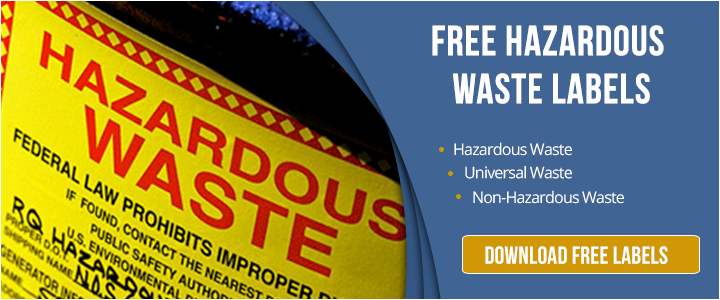Grabbing an adhesive label from the local Office Depot store and writing the words “Hazardous Waste” on it, then slapping it on a storage container and placing it in the warehouse is if nothing else going to give your local DTSC inspector a a good laugh. But it won't get you out of a fine, and even worse it may create a dangerous environment for your employees.
It cannot be stressed enough how important it is for your business to properly label hazardous waste containers.
 Hazardous waste generators that accumulate hazardous waste on-site in containers must be aware of the Resource Conservation and Recovery Act (RCRA) regulations regarding the proper labeling, marking and placarding requirements for hazardous waste containers.
Hazardous waste generators that accumulate hazardous waste on-site in containers must be aware of the Resource Conservation and Recovery Act (RCRA) regulations regarding the proper labeling, marking and placarding requirements for hazardous waste containers.
If you are a hazardous waste generator, once you’ve placed any hazardous waste into a container it becomes necessary to properly mark and label that container.
California DTSC Guidelines
The California Department of Toxic Substances Control (DTSC) provides the following guidance for the proper labeling requirements for California hazardous waste generators pursuant to Title 22, California Code of Regulations (Cal. Code Regs.):
- The date upon which each period of accumulation begins must be clearly marked and visible for inspection on each accumulation unit. (Section 66262.34.)
- While being accumulated on site, each generator tank or container must be labeled or clearly marked with the words, "Hazardous Waste." (Section 66262.34.)
- Each container and portable tank in which hazardous waste is accumulated must be labeled with the following information:
- composition and physical state of the waste;
- statement or statements that call attention to the particular hazardous properties of the waste (e.g. flammable, reactive
- name and address of the generator. (Section 66262.34.)
- Containers and tanks used by the generator to collect or consolidate wastes initially accumulated in other containers or tanks are subject to the same labeling requirements. The initial accumulation and "90-day period" dates on the "collection" container/ tank must be the oldest of the initial accumulation and "90-day period" dates from the various containers/tanks emptied into the "collection" container/tank. This may require dates to be changed if wastes from "older" containers/tanks are added to the "collection" container/tank
- In some cases, containers are continuously reused for accumulation of the same waste stream; e.g., drums used to initially accumulate waste which when full are emptied into larger "collection" containers. "Recurring use" labels may be used on such containers to revise the initial accumulation and "90-day period" dates (without having to change the other labeling information). If the container is emptied at least once each day, the word "daily" may be used in the date area of the label.
DOT Requirements
Before transporting hazardous waste off-site, or offering hazardous waste for off-site transport, a hazardous waste generator must label (40 CFR 262.31) and mark (40 CFR 262.32) each package of hazardous waste, and must placard the waste or offer placards to the initial transporter (40 CFR 262.33). The regulations reference the DOT HMR in 49 CFR Part 172 for hazardous waste labeling, marking, and placarding requirements.
In order to comply with Department of Transportation (DOT) regulations, proper DOT labels must be filled out before the container can be shipped off site. This label is used to identify each waste stream including its name, characteristics, and handling requirements.
- The Proper Shipping Name and identification number of the hazardous material [49 CFR 172.301(a)];
- The name and address of the shipper and/or the designated recipient [49 CFR 173.301(d)];
- The diamond hazard labels for the primary (and most subsidiary) hazard classes of the hazardous material [49 CFR 173.400, 173.402].
Having proper labels on the container is not the only concern. It is also important to place the labels properly on the container. This is important so that labels are not missed by handlers. Labels must appear in their entirety and should not be placed near any other markings on the surface. They should always be visible, so never place them on the bottom of a container.
If the waste has multiple hazards associated with it multiple labels should be displayed next to each other. The DOT recommends a six- inch space (15 cm) between labels. The label designating the primary hazard should be above and to the left of the label designating the subsidiary hazard.
EPA Standards for Hazardous Waste Labels
Industry Standards
The EPA provides the following best practices that are used as industry standards for properly labeling/marking your containers:
- All personnel should use the same method (e.g., handwritten, prepared labels) to label containers.
- Make sure all waste handlers are properly trained and know what the markings mean.
- Besides the start date and the words “Hazardous Waste,” include information about contents (e.g., toxic, reactive, incompatible).
- Apply DOT labels to the container when waste is first placed in the container. The label will be in place for shipment and provides information about the waste to drum handlers.
- Before reusing containers, make sure all old markings/labels are washed off or blacked out.
Follow these tips and you can ensure proper compliance with RCRA and DOT regulations and maintain a safe workplace for your employees, company and community.
Get our free hazardous waste labels to use on your storage containers.


Comment